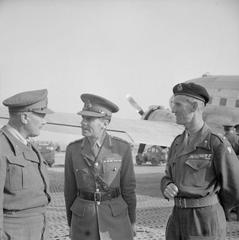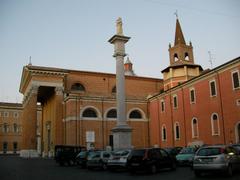Via Aemilia Forlì Visiting Hours, Tickets, and Historical Sites Guide
Date: 14/06/2025
Introduction to Via Aemilia in Forlì, Italy
Via Aemilia in Forlì is a living testament to Roman ingenuity and the enduring legacy of the ancient world in northern Italy. Constructed in 187 BCE by the Roman consul Marcus Aemilius Lepidus, this nearly 260-kilometer consular road connected Rimini on the Adriatic coast to Piacenza near the River Po, cutting across the heart of Emilia-Romagna. Forlì, once known as Forum Livii, flourished at the intersection of Via Aemilia and the road to Tuscany, growing from a Roman forum into a dynamic center for commerce, culture, and governance (Wikipedia; Britannica; Visit Romagna).
Today, Forlì’s historic center preserves elements of the ancient Roman city plan, including its street grid and monumental piazzas. Key sites such as Piazza Aurelio Saffi and the Abbey of San Mercuriale offer visitors a journey through Roman, medieval, and Renaissance eras, complemented by lively cultural events and local gastronomy (The Crazy Tourist; Zainoo).
This guide provides detailed historical context, practical visitor information (including opening hours, ticketing, accessibility, and transportation), and insider tips for exploring Via Aemilia in Forlì. Whether you’re a history buff, a culinary enthusiast, or a curious traveler, you’ll find everything you need to make the most of your visit (Forbes; Overyourplace).
Table of Contents
- Discovering the Via Aemilia: History, Heritage, and How to Visit
- Historical Background of Via Aemilia in Forlì
- Urban and Cultural Significance
- Architectural and Archaeological Highlights
- Economic and Social Impact
- Cultural Experiences & Events
- Practical Visitor Tips
- Preservation & Modern Relevance
- Main Attractions Along Via Aemilia: Hours, Tickets, and Sites
- Getting There & Transportation
- Accessibility & Facilities
- Dining, Shopping, and Local Specialties
- Guided Tours & Experiences
- Sustainability and Responsible Tourism
- Frequently Asked Questions (FAQ)
- Summary and Visit Tips
- References & Further Reading
Discovering the Via Aemilia: History, Heritage, and How to Visit
Roman Origins and Construction
Via Aemilia, built after the Roman conquest of Gallic tribes, exemplifies Roman engineering prowess. Designed as a straight, elevated road often following prehistoric routes, it enabled rapid movement of troops and commerce, ultimately shaping the region’s urban and cultural development (Wikipedia; Visit Romagna).
Strategic and Urban Impact
The road linked major Roman colonies—Bologna (Bononia), Modena (Mutina), Reggio Emilia (Regium), Parma, and Forlì (Forum Livii)—promoting Romanization and prosperity. The resulting network of towns and infrastructure still defines the Emilia-Romagna region’s cityscape (Emilia Romagna Turismo; Travel Emilia Romagna).
Forlì: A Roman Forum at the Crossroads
Founded as Forum Livii around 188 BCE, Forlì’s historic center still follows the ancient street grid. Corso della Repubblica, Via Mazzini, and Via Garibaldi all trace Roman routes converging on Piazza Aurelio Saffi, which occupies the site of the original forum (Visit Romagna; The Crazy Tourist).
Evolution Through the Ages
After Rome’s decline, Forlì retained its importance, flourishing in the Middle Ages under the Ordelaffi family and later Caterina Sforza. The Abbey of San Mercuriale and remnants of the city’s fortifications attest to its medieval and Renaissance prominence (Visit Romagna).
Visiting Today: Hours, Tickets, and Experiences
- Via Aemilia: Always open, free to explore.
- Abbey of San Mercuriale: Daily, 9:00–18:00, free (donations welcome).
- Rocca di Ravaldino: Tue–Sun, 10:00–17:00, €5 adults (discounts for students/seniors).
- San Domenico Museum Complex: Tue–Sun, 10:00–18:00, €7 (combined tickets available).
- Pinacoteca Civica di Forlì: Tue–Sun, 10:00–18:00, €6.
Guided tours in English and Italian are available at most sites; check for seasonal variations and holiday closures (overyourplace.com).
Historical Background of Via Aemilia in Forlì
Via Aemilia, constructed in 187 BCE, connected Ariminum (Rimini) to Placentia (Piacenza), laying the groundwork for centuries of economic and cultural exchange. Forlì’s position as Forum Livii made it a key outpost along the route, facilitating trade, administration, and the spread of Roman culture throughout the Po Valley (Zainoo; Britannica).
Urban and Cultural Significance
Forlì’s very name reflects its role as a Roman forum. The city’s layout, notably Corso della Repubblica, follows the ancient Via Aemilia, serving as a living museum. Through the Middle Ages and Renaissance, Forlì’s strategic location made it a hub for commerce and political power, shaped by ruling families and later the Papal States (Britannica).
Architectural and Archaeological Highlights
- Corso della Repubblica: Follows the ancient Via Aemilia.
- Abbey of San Mercuriale: 12th-century Romanesque, home to Renaissance altarpieces.
- Piazza Aurelio Saffi: Central square, surrounded by historic buildings.
- Rocca di Ravaldino: Medieval fortress, linked to Caterina Sforza (Zainoo).
Economic and Social Impact
The Via Aemilia enabled Forlì to thrive as a center for agriculture and trade, a role it maintains today. The city is a transport hub, with railway and highway connections echoing the ancient road’s route (Britannica).
Cultural Experiences and Events
Forlì’s museums, art galleries, and seasonal markets reflect its heritage. Don’t miss local food festivals and exhibitions at the San Domenico Museum Complex, or sample regional specialties like cured meats and cheeses (Zainoo).
Practical Visitor Tips
- Getting There: By train from Bologna, Rimini, or Ravenna; by car via A14 motorway; by air through Forlì Airport (Britannica).
- Exploring: Walk or cycle along Corso della Repubblica; guided tours are available.
- Best Time: Spring and autumn for mild weather and fewer crowds.
- Cuisine: Try piadina, tagliatelle al ragù, and local wines.
Preservation and Modern Relevance
Forlì actively preserves its Roman and medieval legacy. Educational programs and interpretive signage help visitors appreciate the city’s layered history. The modern SS9 road still follows the ancient Via Aemilia, maintaining its role as a vital economic artery (Britannica; Zainoo).
Main Attractions Along Via Aemilia in Forlì: Visiting Hours, Tickets, and Sites
Piazza Aurelio Saffi
Located on the Roman forum’s original site, the square is open 24/7 and hosts the Town Hall, Chiesa di Santa Lucia, and Abbey of San Mercuriale (inviaggio.touringclub.it).
Abbey of San Mercuriale
Open daily, 9:00–18:00, with free entry and guided tours on request.
Palazzo del Merenda and Biblioteca Civica
A 19th-century palazzo housing Forlì’s public library. Rare manuscripts are accessible by appointment (inviaggio.touringclub.it).
Fortress of Ravaldino (Rocca di Ravaldino)
Open Tue–Sun, 10:00–17:00, €5 entry. Guided tours in English and Italian (overyourplace.com).
Chiesa di Santa Lucia
Baroque church open weekdays, 9:00–13:00 and 15:00–18:00, free admission.
San Domenico Museum Complex
Tue–Sun, 10:00–18:00, €7. Home to art, archaeological collections, and special exhibitions (overyourplace.com).
Pinacoteca Civica di Forlì
Tue–Sun, 10:00–18:00, €6. Features works by Marco Palmezzano and other Italian masters.
Via della Repubblica
Follows the Roman alignment, lined with shops, porticos, and historic residences.
Piazzale della Vittoria
Grand entrance square, open to the public, popular for gatherings and events.
Park of Via Dragoni & Monte Poggiolo
Parks and green spaces for walking, cycling, and relaxation. Monte Poggiolo offers panoramic views and archaeological interest.
Getting There and Transportation
- Train: Forlì railway station is 1.5 km from the center. Frequent trains from Bologna, Rimini, and Ravenna.
- Car: Exit the A14 motorway at Forlì; central parking available.
- Bicycle: City bike rentals and dedicated paths allow easy exploration.
- Local Buses: Connect the station to the center and key attractions.
Accessibility and Facilities
- Most main attractions are wheelchair accessible.
- Public restrooms at Piazza Saffi, San Domenico Museum, and major parks.
- Free Wi-Fi in public areas and some museums.
- The city is considered safe for tourists; standard precautions apply.
Dining, Shopping, and Local Specialties
- Cuisine: Sample piadina, tagliatelle al ragù, tortellini in brodo, and Sangiovese wine.
- Recommended Restaurants: Trattoria Petito, Caffè della Piazza, Osteria Don Abbondio.
- Shopping: Local ceramics, crafts, wines, and regional foods. Markets held in Piazza Saffi. Shops generally open 9:00–13:00 and 16:00–19:30.
Guided Tours and Experiences
- Walking Tours: 2–3 hours, covering key sites and local history, €10–20 per person (womtravel.it).
- Self-Guided: Downloadable maps and audio guides are available through the Forlì tourism office and online.
Sustainability and Responsible Tourism
- Use public transport or bicycles where possible.
- Dispose of waste properly and respect heritage guidelines.
- Support local artisans and responsible businesses.
Frequently Asked Questions (FAQ)
Q: Are tickets required for Via Aemilia or its main attractions?
A: The road itself and Piazza Saffi are free. Museums and the fortress require tickets.
Q: What are typical opening hours for historical sites?
A: Most are open Tue–Sun, 10:00–18:00. Churches may have longer hours.
Q: Is the area accessible for those with mobility challenges?
A: Yes, most main streets and attractions are accessible, but some historic buildings may have limitations.
Q: Are guided tours available in English?
A: Yes, most major sites offer English-language tours.
Q: What’s the best time to visit?
A: Spring and autumn for pleasant weather and fewer crowds.
Summary and Visit Tips for Via Aemilia Forlì
Via Aemilia in Forlì offers a remarkable journey through Roman history, medieval and Renaissance architecture, and lively modern culture. Plan your visit to walk or cycle the ancient route, explore iconic landmarks, and immerse yourself in regional traditions. Practical information on transportation, accessibility, tickets, and local events ensures a seamless and enriching experience. Use guided tours and digital resources for deeper insights, and savor the renowned cuisine of Emilia-Romagna (Visit Romagna; Britannica; Inviaggio Touring Club; Zainoo; Overyourplace; Forbes; Womtravel).
References and Further Reading
- Wikipedia
- Britannica
- Visit Romagna
- The Crazy Tourist
- Zainoo
- Forbes
- Overyourplace
- Inviaggio Touring Club
- Womtravel
For the latest updates, ticket information, and guided tour bookings, download the Audiala app. Explore more about Forlì through our related posts and follow us on social media for travel inspiration.


